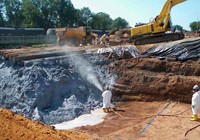Advertisement
Grab your lab coat. Let's get started
Welcome!
Welcome!
Create an account below to get 6 C&EN articles per month, receive newsletters and more - all free.
It seems this is your first time logging in online. Please enter the following information to continue.
As an ACS member you automatically get access to this site. All we need is few more details to create your reading experience.
Not you? Sign in with a different account.
Not you? Sign in with a different account.
ERROR 1
ERROR 1
ERROR 2
ERROR 2
ERROR 2
ERROR 2
ERROR 2
Password and Confirm password must match.
If you have an ACS member number, please enter it here so we can link this account to your membership. (optional)
ERROR 2
ACS values your privacy. By submitting your information, you are gaining access to C&EN and subscribing to our weekly newsletter. We use the information you provide to make your reading experience better, and we will never sell your data to third party members.
Environment
Burden Of Pollution
Superfund: EPA explores tougher financial requirements to ensure that companies pay for cleanups
by Jeff Johnson
January 11, 2010
| A version of this story appeared in
Volume 88, Issue 2

The Environmental Protection Agency is considering new regulations that will require chemical companies to have adequate resources to clean up environmental damage that may result from their operations. In a late-December announcement, EPA said it is taking the first step to ensure that plant owners—not taxpayers—foot the bill for cleaning up pollution under the Superfund law.
In explaining its concern, the agency cited the case of Vertac Chemical, in Jacksonville, Ark. When the firm went bankrupt in 1986, it left behind 29,000 drums of chemical waste and a $127 million cleanup bill to be paid by the federal government. EPA also singled out a Delaware chlorinated-benzene manufacturer that folded in 2002, sticking federal taxpayers with a cleanup tab that is expected to reach $100 million.
EPA has spent some $2.7 billion of taxpayer dollars through 2009 to clean up pollution from bankrupt chemical company plants. In the past, a Superfund tax on chemicals paid for the cost of cleanups when companies could not, but that tax ended in 1995.
By law, EPA must require facility owners to show “evidence of financial responsibility consistent with the degree and duration of risk” from plant operations, the agency noted. But chemical plants, which often handle large quantities of toxic chemicals, can sidestep these requirements by a change of ownership, EPA explained. The agency’s view is supported by a 2005 Government Accountability Office report warning that chemical companies are at risk of incurring huge environmental liabilities but can avoid this liability through bankruptcy.
At this time, EPA said it is seeking comments only on the need for new financial assurance requirements and the form they might take. EPA’s announcement affects not only chemical companies but also petroleum refineries, gas and coal-related industries, and electric power generation companies.
Future requirements are yet to be determined, an EPA official stressed, but options could include insurance or establishment of a dedicated cleanup fund. The American Chemistry Council, an industry trade association, is monitoring the issue and meeting with member companies to gauge the impact the requirements could have, an ACC official said.



Join the conversation
Contact the reporter
Submit a Letter to the Editor for publication
Engage with us on Twitter